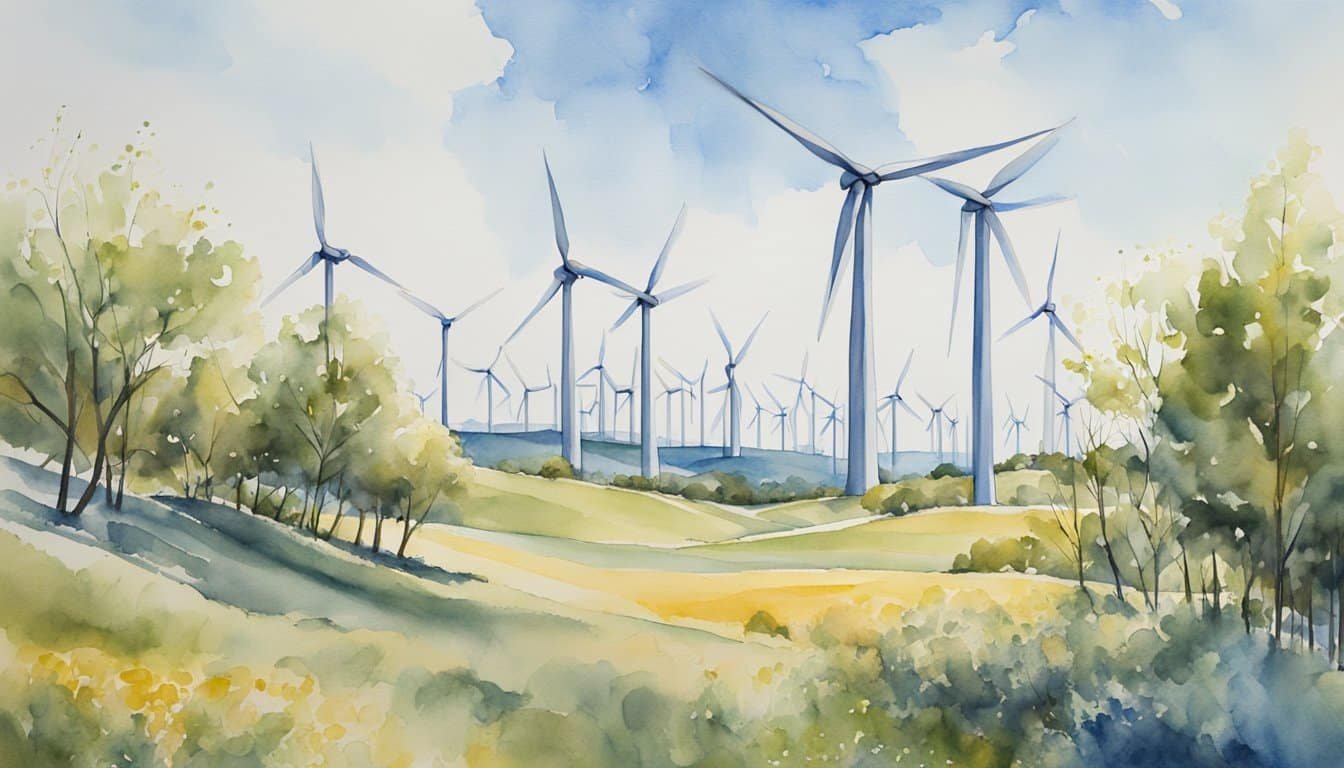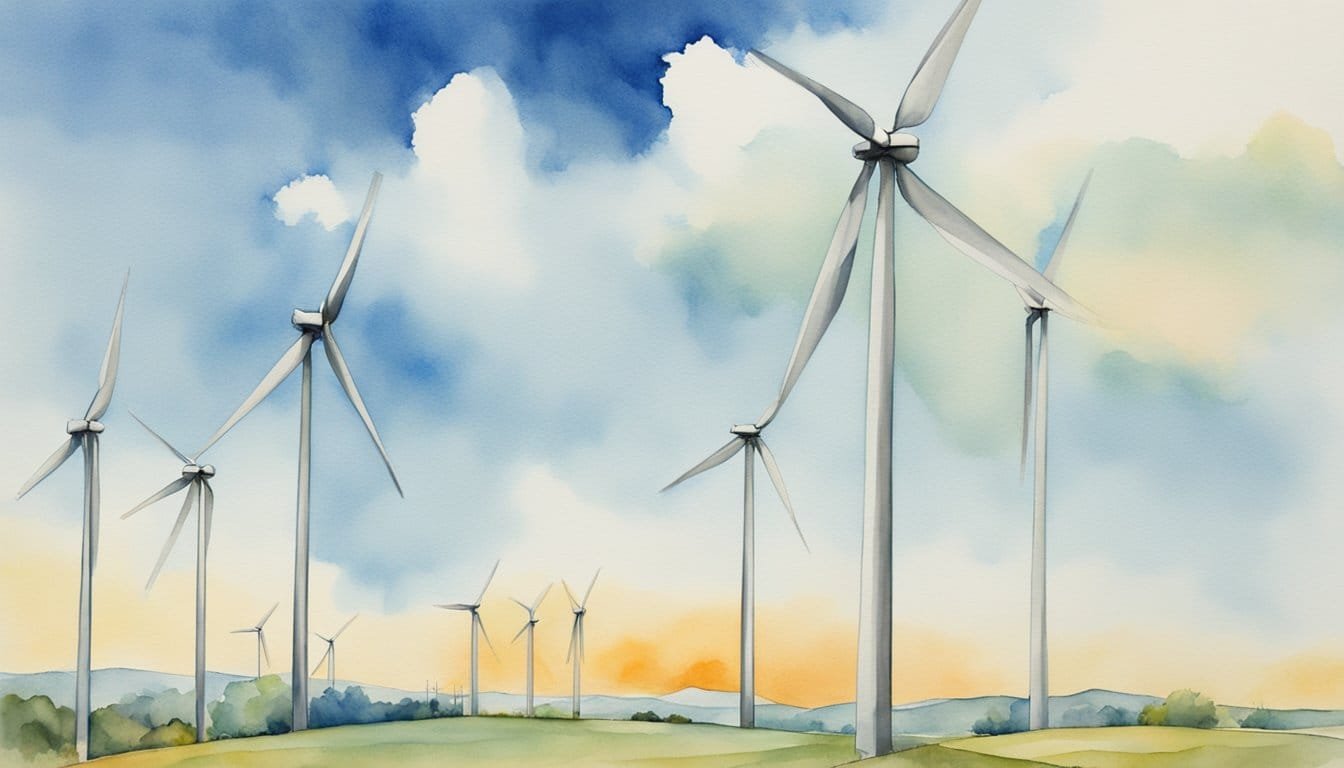Overview of Wind Energy
Wind energy, harnessed by towering wind turbines, is a testament to human innovation’s harmony with nature’s power. Wind power, a segment of renewable energy, has seen significant growth due to its sustainability and lower environmental impact compared to fossil fuels. The technology behind this growth is both impressive and intricate, involving advancements in rotor and blade design to maximize efficiency.
Wind farms, whether spread across vast tracts of land or situated offshore, are becoming increasingly common sights. While land-based wind remains prevalent, with turbines sometimes reaching over 100 meters tall to capture stronger winds at higher altitudes, there’s a surge in offshore wind energy interest. Offshore farms benefit from steadier winds and are not limited by land availability, though they face higher installation and maintenance costs.
Electricity generation from wind has soared, with thousands of megawatts being added annually worldwide. In terms of nameplate capacity — the maximum engineered output of a wind turbine — the numbers keep climbing as utilities commission newly installed wind turbines to meet the growing electricity demands sustainably.
The components of wind energy technology, such as the rotor diameter and the length of blades, are central to a turbine’s generating capacity. Developments in materials and design have allowed for larger, more effective turbines. On average, a single onshore wind turbine can power over 500 homes, while some of the most sizable offshore turbines can individually power thousands due to their larger size and stronger, more consistent winds.
Distributed wind energy, which involves smaller-scale turbines used on-site for homes, farms, or small businesses, plays an important role. It allows for energy independence and contributes to a diversified and resilient energy grid.
As investment in wind power technologies continues, its role in the global energy mix is likely to become increasingly significant, serving as a key player in the transition to a more renewable-based electricity generation system. Check out an overview of wind energy potential and current wind energy statuses for more eye-opening details.
Economic Aspects of Wind Power

When we talk about wind energy, it’s essential to understand Levelized Cost of Energy (LCOE). This nifty term refers to the average cost to generate a unit of electricity over a wind turbine’s lifespan. It’s like a fiscal crystal ball that helps predict future financial performance.
Wind energy has seen its costs plummet in recent years. According to the U.S. Department of Energy’s Land-Based Wind Market Report, the installed cost of wind power plants – that’s the total investment required to get them up and spinning – has dipped, making wind a competitive energy source with its fossil-fueled friends.
Speaking of investments, plunging wind turbine prices are making heads turn among investors. They’re realizing that funding the gusty giants is a move that can pay off as research continues to push technology boundaries, yielding larger and much more efficient turbines.
For a wind power plant like Vineyard Wind I, the first large-scale offshore wind power plant in the U.S., financing can be intricate. Power Purchase Agreements (PPAs) come into play as they lock in the price of energy for consumers, thereby giving investors a stable expectation of returns.
It’s not all breezy, though. Wind power has its own quirks with variability – as in, it depends on how much the wind actually feels like blowing. But fear not! Innovations in energy storage and grid management are helping to smooth out that unpredictability.
Even policies wade into these windy waters. The Production Tax Credit, for example, has swayed the economics considerably, encouraging the adoption of wind energy by dangling the carrot of tax incentives.
In a nutshell, wind energy economics have a lot going for them: plummeting costs, improving technologies, supportive policies, and creative financing mechanisms. Who knew so much was whirling around in the world of wind power?
Wind Energy and Policy Development

The United States has been steering towards a greener future, and the Biden Administration plays a pivotal role in this transition. With an emphasis on renewable energy, particularly wind power, policies are shaping up to fuel growth and create jobs.
For example, the Wind Energy Technologies Office prioritizes innovations in wind power. One of the fascinating facts about wind energy is its capacity factor, which measures the actual output over a period as a percentage of the total potential output.
In the quest for clean energy, the health and climate benefits of wind energy cannot be overstressed. Reduction in fossil fuel use correlates with healthier air and a decline in carbon emissions, helping to tackle climate change head-on.
Specific areas, such as the New York Bight, have been identified as potential wind energy areas. This initiative reflects the strategic approach to bolster energy generation from wind while considering environmental impacts.
The cost of wind energy review indicates that, while upfront costs exist, the long-term economic potential is significant. Compared to fossil fuels, wind energy presents a sustainable edge, tipping the scales in favor of its long-term adoption.
Wind power also coexists with solar power, another renewable heavyweight. Together, they’re reshaping how the nation views energy generation, carving out a pathway to a resilient and sustainable energy infrastructure.

